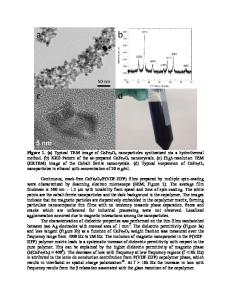Direct-Write Fabrication of Polymer Nanocomposite Fibers
- PDF / 186,379 Bytes
- 5 Pages / 612 x 792 pts (letter) Page_size
- 54 Downloads / 419 Views
1143-KK05-18
Direct-Write Fabrication of Polymer Nanocomposite Fibers Scott M. Berry1, Santosh Pabba2, Scott D. Cambron1,3, Robert W. Cohn2, and Robert S. Keynton1,2,3 University of Louisville Departments of Mechanical Engineering1, the ElectroOptics Research Institute and Nanotechnology Center2, and Bioengineering3 Louisville, KY 40208, U.S.A. ABSTRACT The unique properties of carbon-nanotube (CNT)-doped polymers have generated several promising applications including gas sensors, high-strength/light-weight materials, and electromagnetic interference shielding. The ability to process CNT-doped materials into complex architectures may enable further advancement of these devices. We have developed a directwrite technique for processing CNT-doped poly(methyl methacrylate) (PMMA) into 3D arrays of precisely-positioned, semiconductive fibers with micro- and sub-microscale diameters. In this method, a programmable micromanipulator-controlled syringe was loaded with solvated CNT/PMMA and utilized to draw an array of freely-suspended solution filaments on a substrate in a “connect-the-dots” fashion. As the filaments are drawn, they are thinned by surface tensiondriven necking as they dry and form solid fibers. The degree of thinning can be controlled by varying the PMMA concentration or the fiber length. INTRODUCTION Typically, carbon nanotube (CNT)-reinforced composites are produced by blending CNTs with a solvated or melted polymer, the processing the resultant mixture into fibers via melt spinning [1-4], wet spinning [5, 6], or electrospinning [7, 8]. These three methods are suitable for producing large quantities of fibrous material, but none offers the ability to precisely-position individual fibers in 3D. Recently, work by our group and others has developed a micromanipulator-controlled “direct-write” process which utilizes surface tension-driven necking to produce micro- and sub-microscale filaments from non-conductive polymer solutions [9, 10]. Doping insulating polymers with CNTs has resulting in a conductivity increase of several orders of magnitude. Benoit et al. noted an increase in conductivity from 100 µm. Measurement of these fibers via SEM revealed several trends: Fiber diameter was not influenced by CNT concentration, but increased with increasing PMMA concentration (P
Data Loading...











